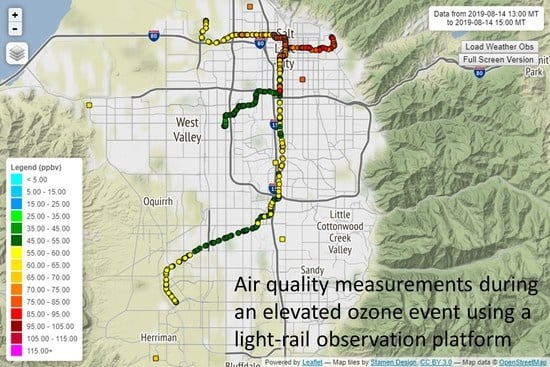The TRAX Light-Rail Train Air Quality Observation Project
Abstract
1. Introduction
1.1. Motivation
1.1.1. Air Quality in the Salt Lake Valley, Utah
1.1.2. Sustainability Goals–Population Growth in the SLV
1.1.3. Health Outcomes
1.2. Previous Work
1.2.1. Air Quality Studies in the Salt Lake Valley
1.2.2. Pilot Mobile Air Quality TRAX Project
1.2.3. Overview of Recent Mobile Urban Air Quality Studies
1.2.4. Sociodemographic and Emission Characteristics
1.3. What this Adds to Previous Work
1.3.1. New Equipment on TRAX Trains and Quality Control and Quality Assurance of Data
1.3.2. Public Awareness via Web Interface
1.3.3. Support of Air Quality Initiatives by Policymakers and Health Agencies
2. Materials and Methods
2.1. Location and Equipment
2.2. Data Recorded
2.3. Quality Control/Quality Assurance
3. Results
3.1. Quality Assurance/Quality Control Results
3.1.1. TRAX-Mounted Sensor Comparison with RAIL1 Stationary Site
3.1.2. Comparison with HW Regulatory Site
3.2. Elevated Ozone Case Study: August 8th, 2019
3.3. Elevated PM2.5 Case Study: July 4th, 2019 Fireworks
3.4. Elevated PM2.5 Case Study: November 8th, 2019
4. Discussion
4.1. Quality Control and Quality Assurance
4.2. Ozone Events
4.3. PM2.5 Events
5. Conclusions
5.1. Implications
5.2. Limitations
5.3. Future Work
Author Contributions
Funding
Acknowledgments
Conflicts of Interest
Abbreviations
| CH4 | Methane |
| CO2 | Carbon dioxide |
| EPA | Environmental Protection Agency |
| NAAQS | National Ambient Air Quality Standards |
| NO2 | Nitrogen dioxide |
| NOx | Nitrogen oxides |
| O3 | Ozone |
| PM2.5 | Fine particulate matter |
| QA | Quality Assurance |
| QC | Quality Control |
| SLC | Salt Lake City |
| SLV | Salt Lake Valley |
| TRAX | Transit Express |
| UofU | University of Utah |
| UDAQ | Utah Division of Air Quality |
| UTA | Utah Transit Authority |
References
- Kem, C.; Gardner Policy Institute. Utah’s Long-Term Demographic and Economic Projections; Gardner Policy Institute: Salt Lake City, UT, USA, 2017. [Google Scholar]
- Lareau, N.P.; Crosman, E.; Whiteman, C.D.; Horel, J.D.; Hoch, S.W.; Brown, W.O.J.; Horst, T.W. The Persistent Cold-Air Pool Study. Bull. Am. Meteorol. Soc. 2012, 94, 51–63. [Google Scholar] [CrossRef]
- Horel, J.; Crosman, E.; Jacques, A.; Blaylock, B.; Arens, S.; Long, A.; Sohl, J.; Martin, R. Summer ozone concentrations in the vicinity of the Great Salt Lake. Atmos. Sci. Lett. 2016, 17, 480–486. [Google Scholar] [CrossRef]
- Crosman, E.T.; Horel, J.D. Winter lake breezes near the Great Salt Lake. Bound.-Layer Meteorol. 2016, 159, 439–464. [Google Scholar] [CrossRef]
- Baasandorj, M.; Hoch, S.W.; Bares, R.; Lin, J.C.; Brown, S.S.; Millet, D.B.; Martin, R.; Kelly, K.; Zarzana, K.J.; Whiteman, C.D.; et al. Coupling between Chemical and Meteorological Processes under Persistent Cold-Air Pool Conditions: Evolution of Wintertime PM2.5 Pollution Events and N2O5 Observations in Utah’s Salt Lake Valley. Environ. Sci. Technol. 2017, 51, 5941–5950. [Google Scholar] [CrossRef]
- Whiteman, C.D.; Hoch, S.W.; Horel, J.D.; Charland, A. Relationship between particulate air pollution and meteorological variables in Utah’s Salt Lake Valley. Atmos. Environ. 2014, 94, 742–753. [Google Scholar] [CrossRef]
- Mitchell, L.E.; Crosman, E.T.; Jacques, A.A.; Fasoli, B.; Leclair-Marzolf, L.; Horel, J.; Bowling, D.R.; Ehleringer, J.R.; Lin, J.C. Monitoring of greenhouse gases and pollutants across an urban area using a light-rail public transit platform. Atmos. Environ. 2018, 187, 9–23. [Google Scholar] [CrossRef]
- Blaylock, B.K.; Horel, J.D.; Crosman, E.T. Impact of Lake Breezes on Summer Ozone Concentrations in the Salt Lake Valley. J. Appl. Meteorol. Climatol. 2017, 56, 353–370. [Google Scholar] [CrossRef]
- Wasatch Front Regional Council. Regional Transportation Plan 2015–2040; Wasatch Front Regional Council: Salt Lake City, UT, USA, 2015. [Google Scholar]
- Wasatch Front Regional Council. Wasatch Choice for 2040 Vision 2011–2040 Regional Transportation Plan; Wasatch Front Regional Council: Salt Lake City, UT, USA, 2011. [Google Scholar]
- American Lung Association. State of the Air 2018; American Lung Association: Chicago, IL, USA, 2018. [Google Scholar]
- Utah Department of Environmental Quality. Utah Division of Air Quality 2017 Annual Report; Utah Department of Environmental Quality: Salt Lake City, UT, USA, 2017. [Google Scholar]
- Pirozzi, C.S.; Jones, B.E.; VanDerslice, J.A.; Zhang, Y.; Paine, R., III; Dean, N.C. Short-Term Air Pollution and Incident Pneumonia. A Case–Crossover Study. Ann. Am. Thorac. Soc. 2018, 15, 449–459. [Google Scholar] [CrossRef]
- Horne, B.D.; Joy, E.A.; Hofmann, M.G.; Gesteland, P.H.; Cannon, J.B.; Lefler, J.S.; Blagev, D.P.; Korgenski, E.K.; Torosyan, N.; Hansen, G.I. Short-term elevation of fine particulate matter air pollution and acute lower respiratory infection. Am. J. Respir. Crit. Care Med. 2018, 198, 759–766. [Google Scholar] [CrossRef]
- Pope, C.A., 3rd; Renlund, D.G.; Kfoury, A.G.; May, H.T.; Horne, B.D. Relation of heart failure hospitalization to exposure to fine particulate air pollution. Am. J. Cardiol. 2008, 102, 1230–1234. [Google Scholar] [CrossRef]
- Pope, C.A., 3rd; Muhlestein, J.B.; May, H.T.; Renlund, D.G.; Anderson, J.L.; Horne, B.D. Ischemic heart disease events triggered by short-term exposure to fine particulate air pollution. Circulation 2006, 114, 2443–2448. [Google Scholar] [CrossRef] [PubMed]
- Hackmann, D.; Sjöberg, E. Ambient air pollution and pregnancy outcomes—A study of functional form and policy implications. Air Qual. Atmos. Health 2016, 10, 129–137. [Google Scholar] [CrossRef]
- Hales, N.M.; Barton, C.C.; Ransom, M.R.; Allen, R.T.; Pope, C.A., 3rd. A Quasi-Experimental Analysis of Elementary School Absences and Fine Particulate Air Pollution. Medicine 2016, 95, e2916. [Google Scholar] [CrossRef] [PubMed]
- Bares, R.; Lin, J.C.; Hoch, S.W.; Baasandorj, M.; Mendoza, D.L.; Fasoli, B.; Mitchell, L.; Catharine, D.; Stephens, B.B. The Wintertime Covariation of CO2 and Criteria Pollutants in an Urban Valley of the Western United States. J. Geophys. Res. Atmos. 2018, 123, 2684–2703. [Google Scholar] [CrossRef]
- Li, Z.; Che, W.; Frey, H.C.; Lau, A.K.; Lin, C. Characterization of PM2. 5 exposure concentration in transport microenvironments using portable monitors. Environ. Pollut. 2017, 228, 433–442. [Google Scholar] [CrossRef]
- Frey, H.C. Trends in onroad transportation energy and emissions. J. Air Waste Manag. Assoc. 2018, 68, 514–563. [Google Scholar] [CrossRef]
- Morawska, L.; Ristovski, Z.; Johnson, G.R.; Jayaratne, E.; Mengersen, K. Novel method for on-road emission factor measurements using a plume capture trailer. Environ. Sci. Technol. 2007, 41, 574–579. [Google Scholar] [CrossRef]
- Adams, M.; Corr, D. A Mobile Air Pollution Monitoring Data Set. Data 2019, 4, 2. [Google Scholar] [CrossRef]
- Apte, J.S.; Messier, K.P.; Gani, S.; Brauer, M.; Kirchstetter, T.W.; Lunden, M.M.; Marshall, J.D.; Portier, C.J.; Vermeulen, R.C.; Hamburg, S.P. High-resolution air pollution mapping with Google street view cars: Exploiting big data. Environ. Sci. Technol. 2017, 51, 6999–7008. [Google Scholar] [CrossRef]
- Messier, K.P.; Chambliss, S.E.; Gani, S.; Alvarez, R.; Brauer, M.; Choi, J.J.; Hamburg, S.P.; Kerckhoffs, J.; LaFranchi, B.; Lunden, M.M. Mapping air pollution with google street view cars: Efficient Approaches with mobile monitoring and land use regression. Environ. Sci. Technol. 2018, 52, 12563–12572. [Google Scholar] [CrossRef]
- Kwak, K.-H.; Woo, S.; Kim, K.; Lee, S.-B.; Bae, G.-N.; Ma, Y.-I.; Sunwoo, Y.; Baik, J.-J. On-road air quality associated with traffic composition and street-canyon ventilation: Mobile monitoring and CFD modeling. Atmosphere 2018, 9, 92. [Google Scholar] [CrossRef]
- Li, Z.; Fung, J.C.; Lau, A.K. High spatiotemporal characterization of on-road PM2.5 concentrations in high-density urban areas using mobile monitoring. Build. Environ. 2018, 143, 196–205. [Google Scholar] [CrossRef]
- Guan, Y.; Johnson, M.C.; Katzfuss, M.; Mannshardt, E.; Messier, K.P.; Reich, B.J.; Song, J.J. Fine-scale spatiotemporal air pollution analysis using mobile monitors on Google Street View vehicles. J. Am. Stat. Assoc. 2019, 1–14. [Google Scholar] [CrossRef]
- Sun, W.; Deng, L.; Wu, G.; Wu, L.; Han, P.; Miao, Y.; Yao, B. Atmospheric Monitoring of Methane in Beijing Using a Mobile Observatory. Atmosphere 2019, 10, 554. [Google Scholar] [CrossRef]
- Minet, L.; Liu, R.; Valois, M.-F.; Xu, J.; Weichenthal, S.; Hatzopoulou, M. Development and Comparison of Air Pollution Exposure Surfaces Derived from On-Road Mobile Monitoring and Short-Term Stationary Sidewalk Measurements. Environ. Sci. Technol. 2018, 52, 3512–3519. [Google Scholar] [CrossRef]
- Targino, A.C.; Rodrigues, M.V.C.; Krecl, P.; Cipoli, Y.A.; Ribeiro, J.P.M. Commuter exposure to black carbon particles on diesel buses, on bicycles and on foot: A case study in a Brazilian city. Environ. Sci. Pollut. Res. 2018, 25, 1132–1146. [Google Scholar] [CrossRef]
- Lim, C.C.; Kim, H.; Vilcassim, M.R.; Thurston, G.D.; Gordon, T.; Chen, L.-C.; Lee, K.; Heimbinder, M.; Kim, S.-Y. Mapping urban air quality using mobile sampling with low-cost sensors and machine learning in Seoul, South Korea. Environ. Int. 2019, 131, 105022. [Google Scholar] [CrossRef]
- Castellini, S.; Moroni, B.; Cappelletti, D. PMetro: Measurement of urban aerosols on a mobile platform. Measurement 2014, 49, 99–106. [Google Scholar] [CrossRef]
- Hagemann, R.; Corsmeier, U.; Kottmeier, C.; Rinke, R.; Wieser, A.; Vogel, B. Spatial variability of particle number concentrations and NOx in the Karlsruhe (Germany) area obtained with the mobile laboratory ‘AERO-TRAM’. Atmos. Environ. 2014, 94, 341–352. [Google Scholar] [CrossRef]
- Castell, N.; Kobernus, M.; Liu, H.-Y.; Schneider, P.; Lahoz, W.; Berre, A.J.; Noll, J. Mobile technologies and services for environmental monitoring: The Citi-Sense-MOB approach. Urban Clim. 2015, 14, 370–382. [Google Scholar] [CrossRef]
- Hasenfratz, D.; Saukh, O.; Walser, C.; Hueglin, C.; Fierz, M.; Arn, T.; Beutel, J.; Thiele, L. Deriving high-resolution urban air pollution maps using mobile sensor nodes. Pervasive Mob. Comput. 2015, 16, 268–285. [Google Scholar] [CrossRef]
- Yang, F.; Zhang, J.; Xing, Y.; He, J.; Zhang, K.; Westerdahl, D.; Ning, Z. Deployment of Mobile Air Sensing Network for Urban Air Pollution Monitoring in Hong Kong. Multidiscip. Digit. Publ. Inst. Proc. 2017, 1, 775. [Google Scholar] [CrossRef]
- Xing, Y.; Brimblecombe, P.; Ning, Z. Fine-scale spatial structure of air pollutant concentrations along bus routes. Sci. Total Environ. 2019, 658, 1–7. [Google Scholar] [CrossRef] [PubMed]
- Lin, J.C.; Mitchell, L.; Crosman, E.; Mendoza, D.L.; Buchert, M.; Bares, R.; Fasoli, B.; Bowling, D.R.; Pataki, D.; Catharine, D.; et al. CO2 and Carbon Emissions from Cities: Linkages to Air Quality, Socioeconomic Activity, and Stakeholders in the Salt Lake City Urban Area. Bull. Am. Meteorol. Soc. 2018, 99, 2325–2339. [Google Scholar] [CrossRef]
- Patarasuk, R.; Gurney, K.R.; O’Keeffe, D.; Song, Y.; Huang, J.; Rao, P.; Buchert, M.; Lin, J.C.; Mendoza, D.; Ehleringer, J.R. Urban high-resolution fossil fuel CO2 emissions quantification and exploration of emission drivers for potential policy applications. Urban Ecosyst. 2016, 19, 1013–1039. [Google Scholar] [CrossRef]
- Kanda, I. Measurement of ozone concentration on the elevation gradient of a low hill by a semiconductor-based portable monitor. Atmosphere 2015, 6, 928–941. [Google Scholar] [CrossRef]
- Langford, A.O.; Alvarez, I.; Raul, J.; Kirgis, G.; Senff, C.J.; Caputi, D.; Conley, S.A.; Faloona, I.C.; Iraci, L.T.; Marrero, J.E. Intercomparison of lidar, aircraft, and surface ozone measurements in the San Joaquin Valley during the California Baseline Ozone Transport Study (CABOTS). Atmos. Meas. Tech. 2019, 12, 1889–1904. [Google Scholar] [CrossRef]
- Met One Instruments, Inc. ES-642 Dust Monitor Operation Manual; Met One Instruments, Inc.: Grants Pass, OR, USA, 2013. [Google Scholar]
- 2B Technologies, Inc. Ozone Monitor Operation Manual Model 205; 2B Technologies, Inc.: Boulder, CO, USA, 2018. [Google Scholar]
- Call, B. Personal Communication; Utah Division of Air Quality: Salt Lake City, UT, USA, 2019. [Google Scholar]
- United States Environmental Protection Agency Air Quality Index (AQI) Basics. Available online: https://airnow.gov/index.cfm?action=aqibasics.aqi (accessed on 30 November 2019).
- Dickerson, A.S.; Benson, A.F.; Buckley, B.; Chan, E.A. Concentrations of individual fine particulate matter components in the USA around July 4th. Air Qual. Atmos. Health 2017, 10, 349–358. [Google Scholar] [CrossRef]
- Pho, B.; T Ock, P.H.O. Cleaner urban air tomorrow? Nat. Geosci. 2017, 10, 69. [Google Scholar]
- Kulshrestha, U.; Rao, T.N.; Azhaguvel, S.; Kulshrestha, M. Emissions and accumulation of metals in the atmosphere due to crackers and sparkles during Diwali festival in India. Atmos. Environ. 2004, 38, 4421–4425. [Google Scholar] [CrossRef]
- Camilleri, R.; Vella, A.J. Effect of fireworks on ambient air quality in Malta. Atmos. Environ. 2010, 44, 4521–4527. [Google Scholar] [CrossRef]
- Zhao, W.; Fan, S.-J.; Xie, W.-Z.; Sun, J.-R. Influence of Burning Fireworks on Air Quality During the Spring Festival in the Pearl River Delta. Huan Jing Ke Xue 2015, 36, 4358–4365. [Google Scholar] [PubMed]
- Setianto, A.; Triandini, T. Comparison of kriging and inverse distance weighted (IDW) interpolation methods in lineament extraction and analysis. J. Appl. Geol. 2013, 5. [Google Scholar] [CrossRef]
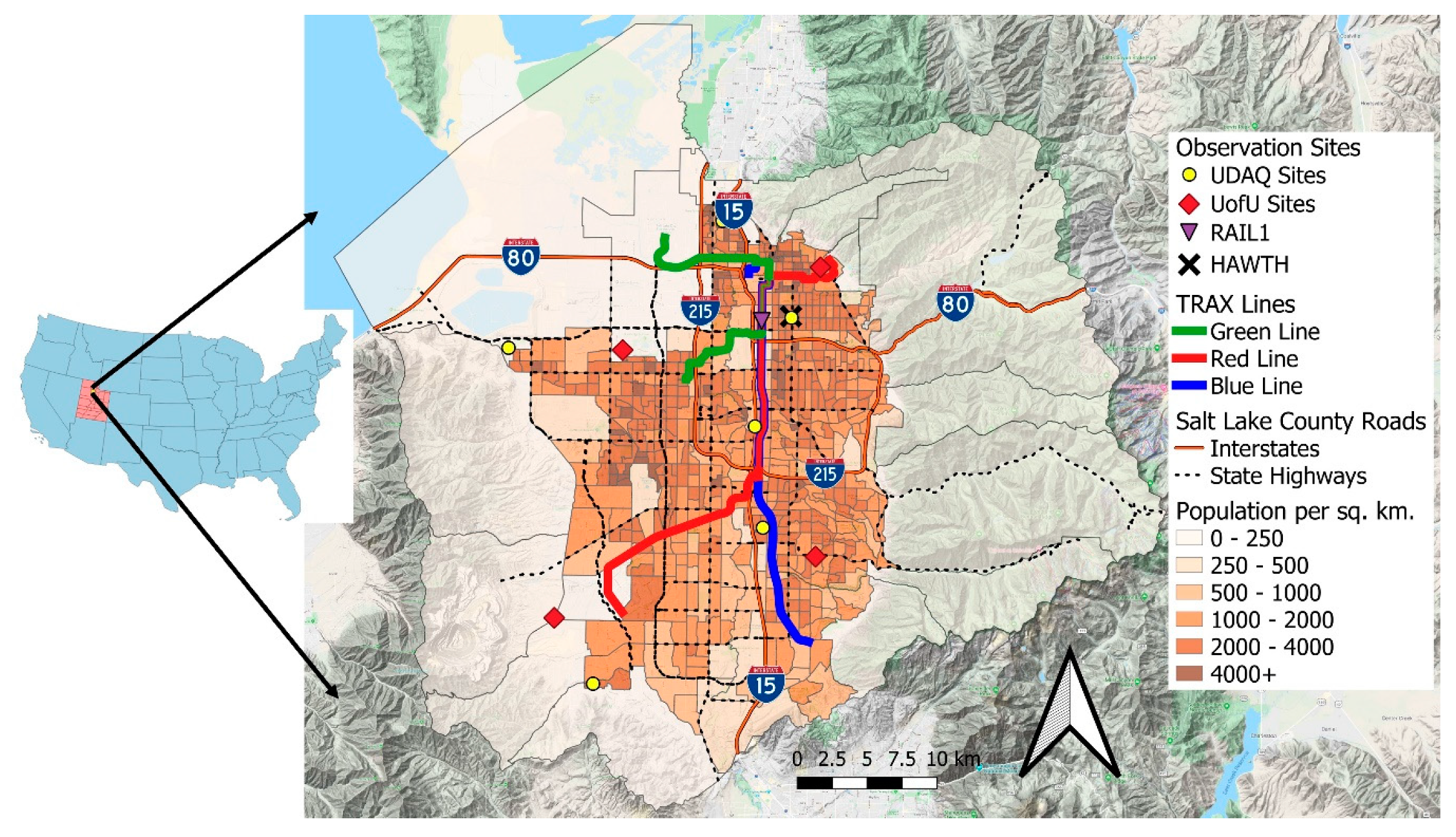
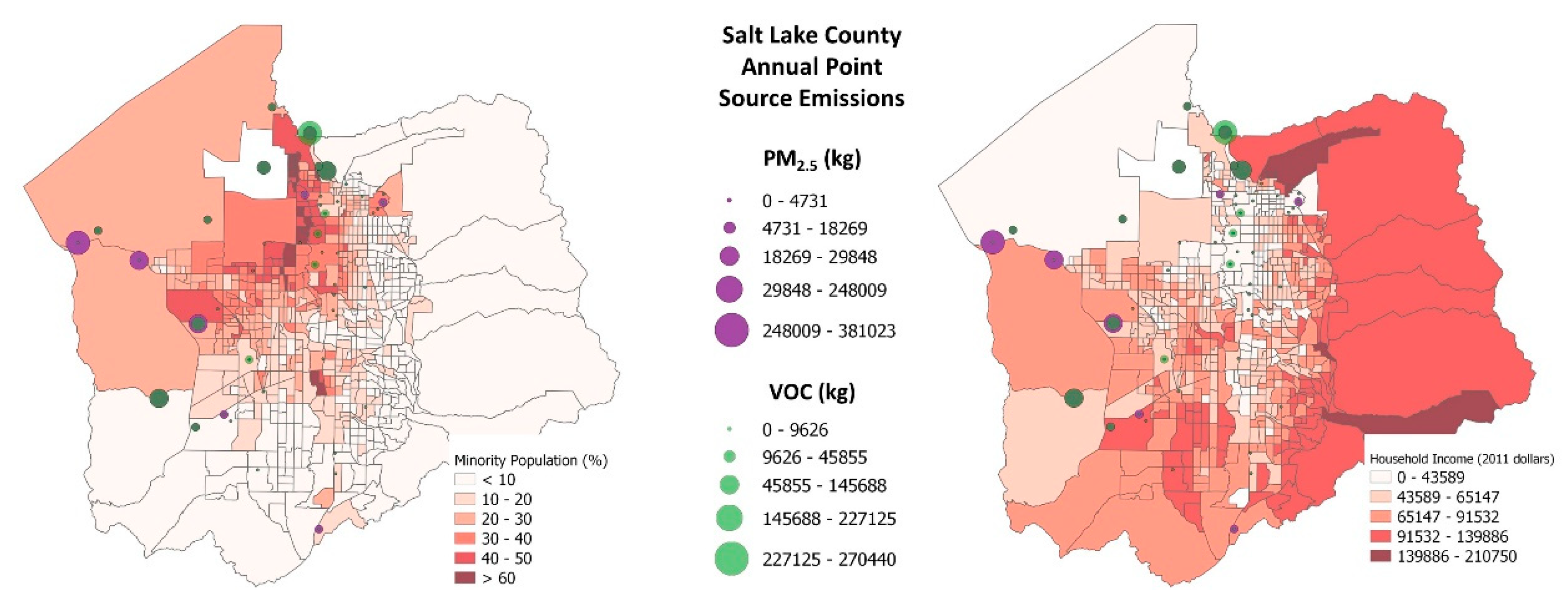

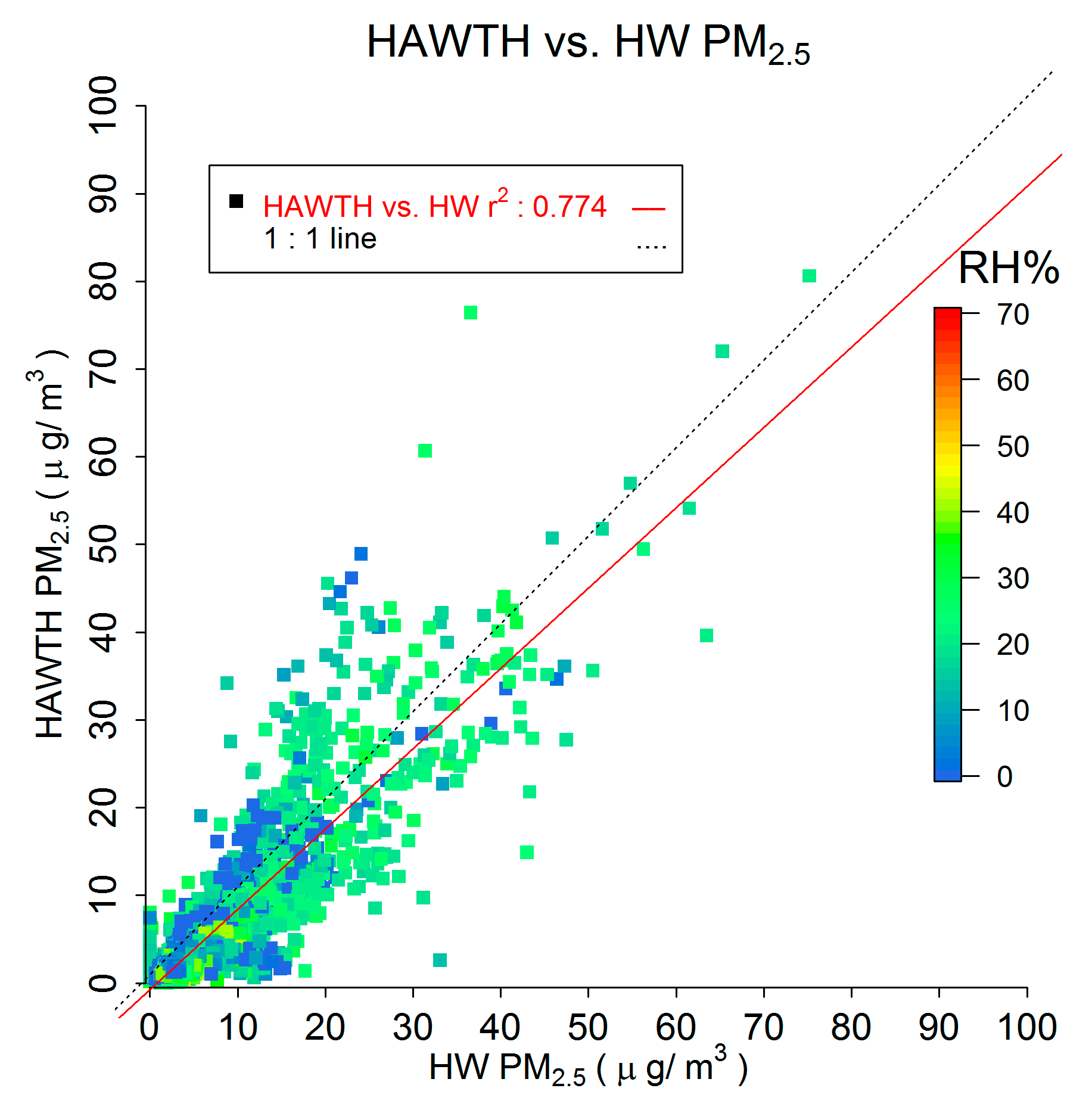
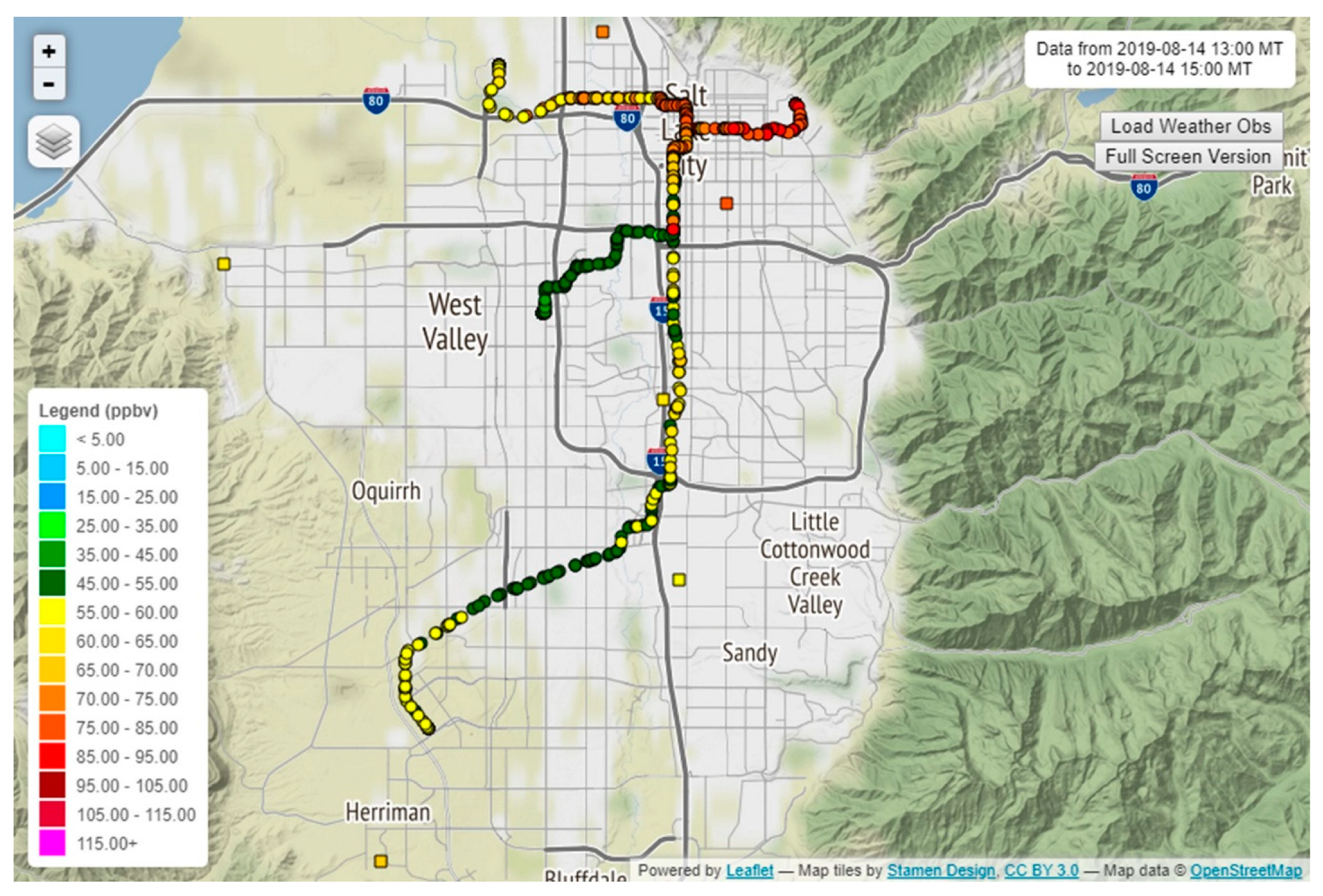
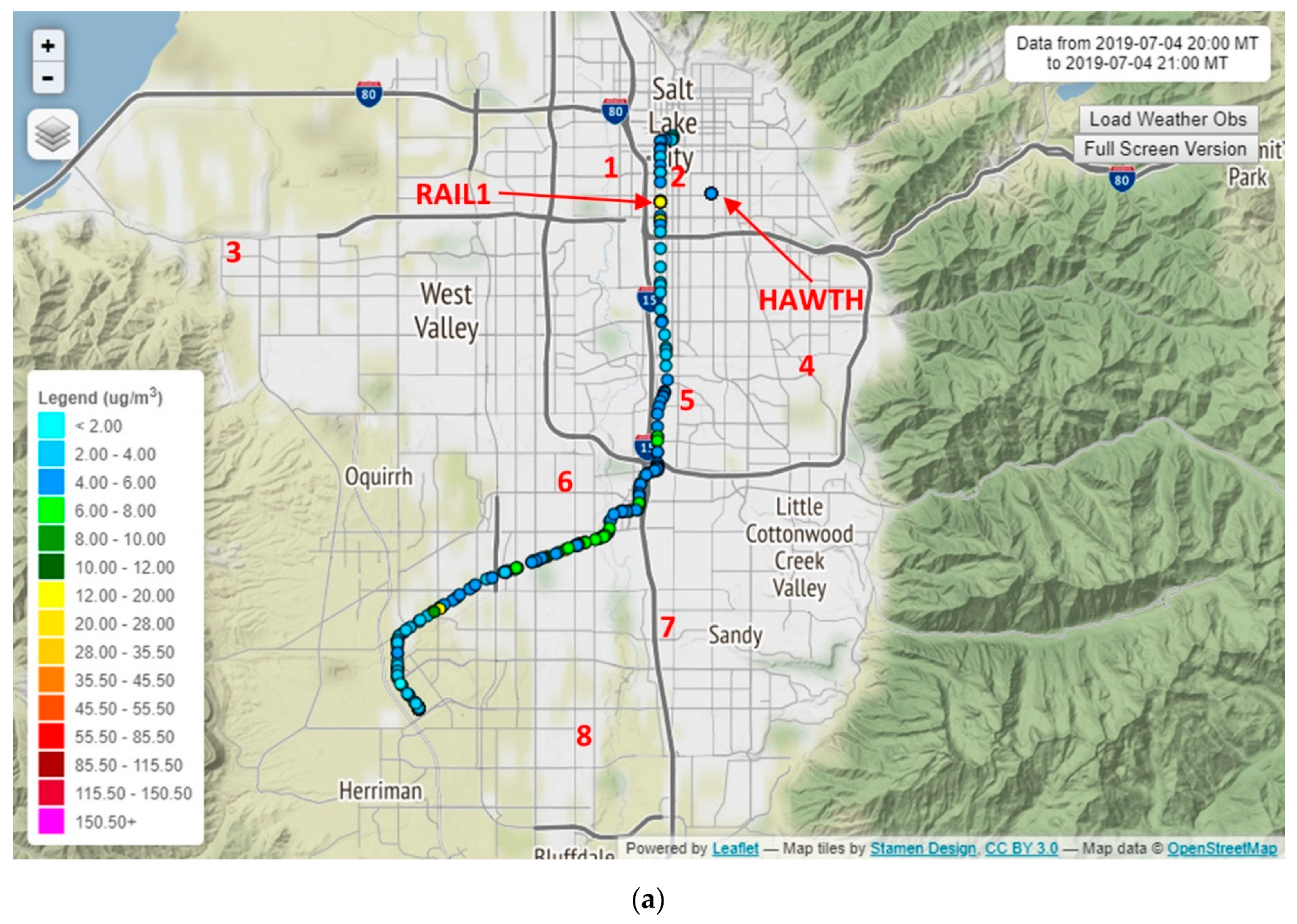

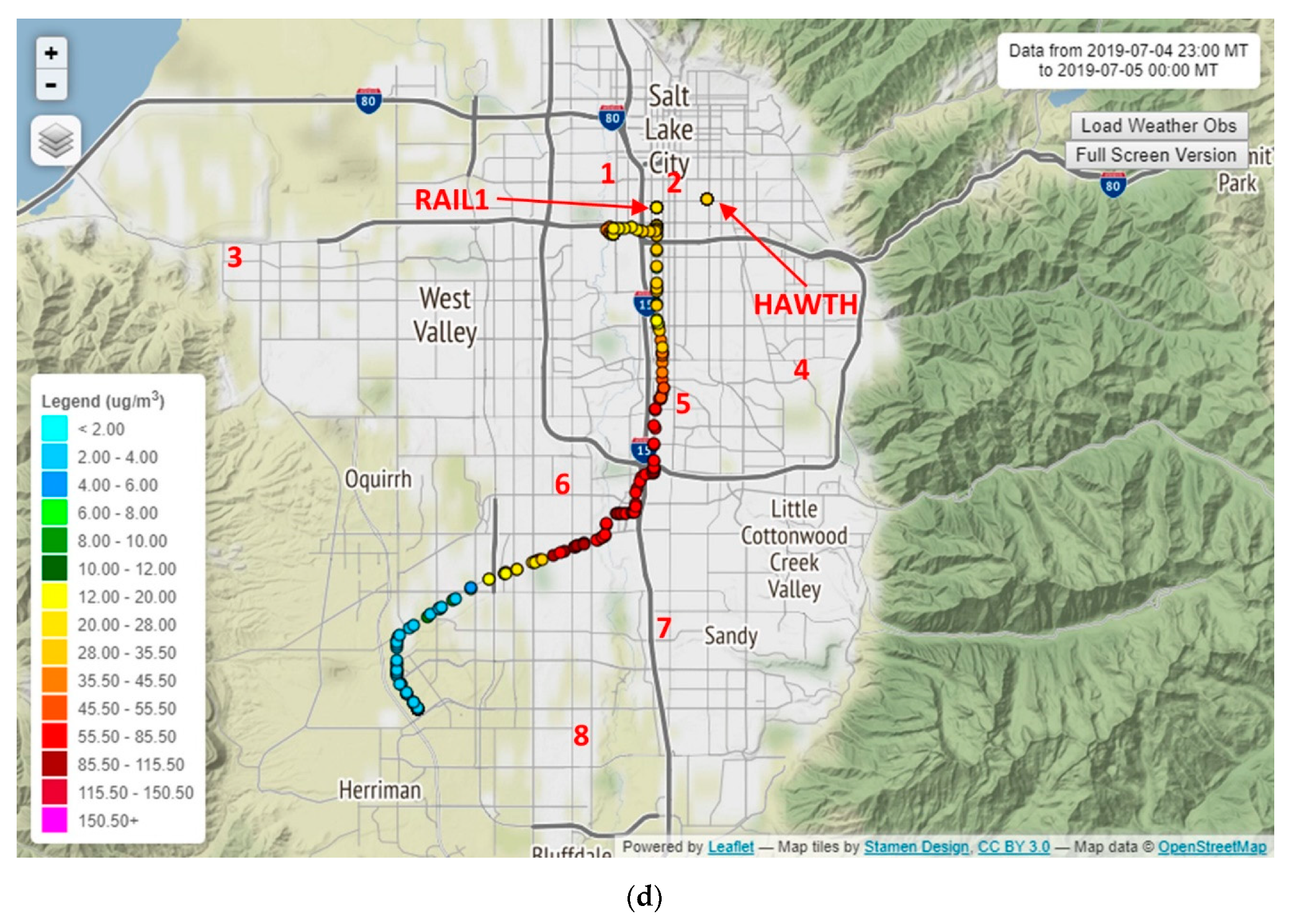
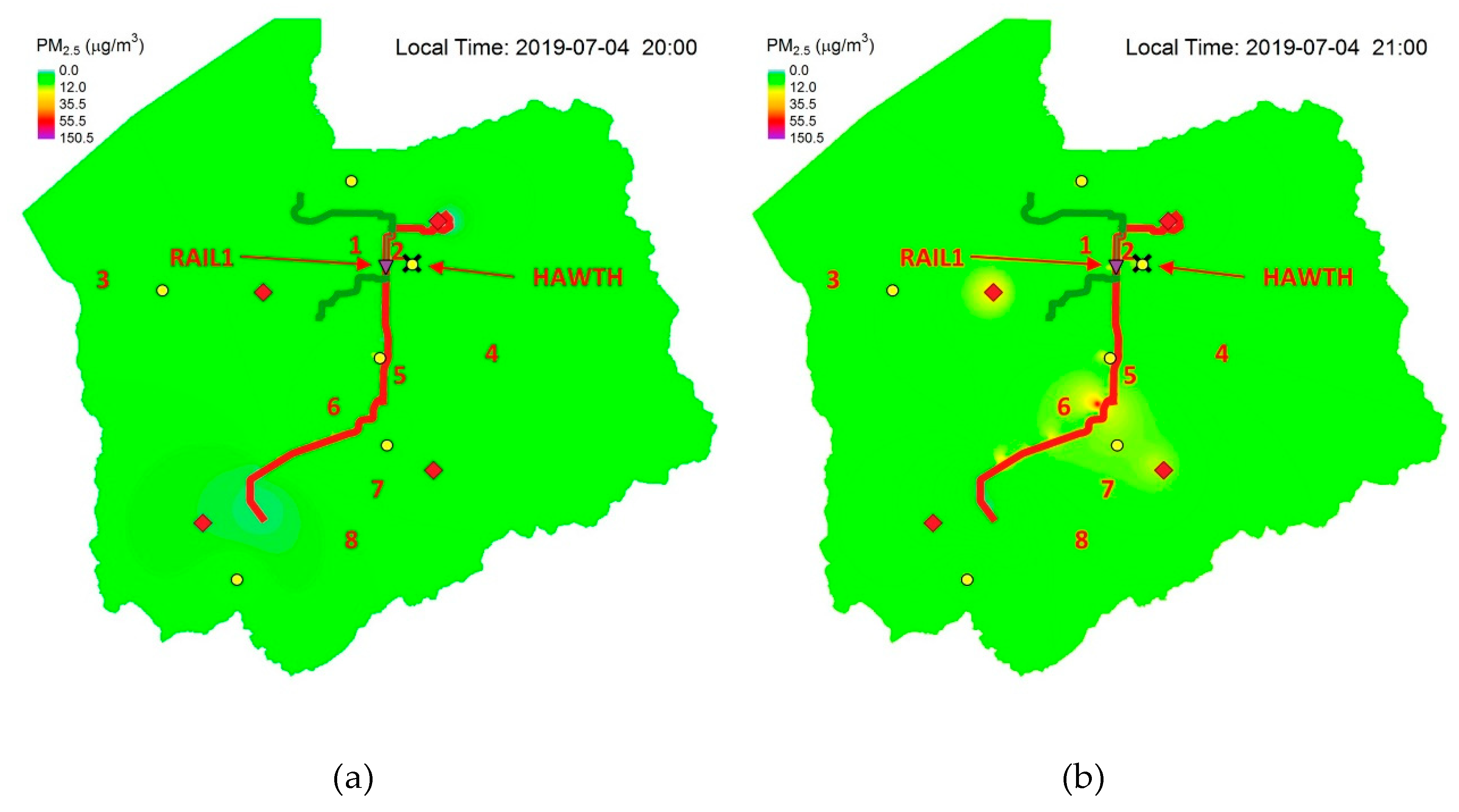
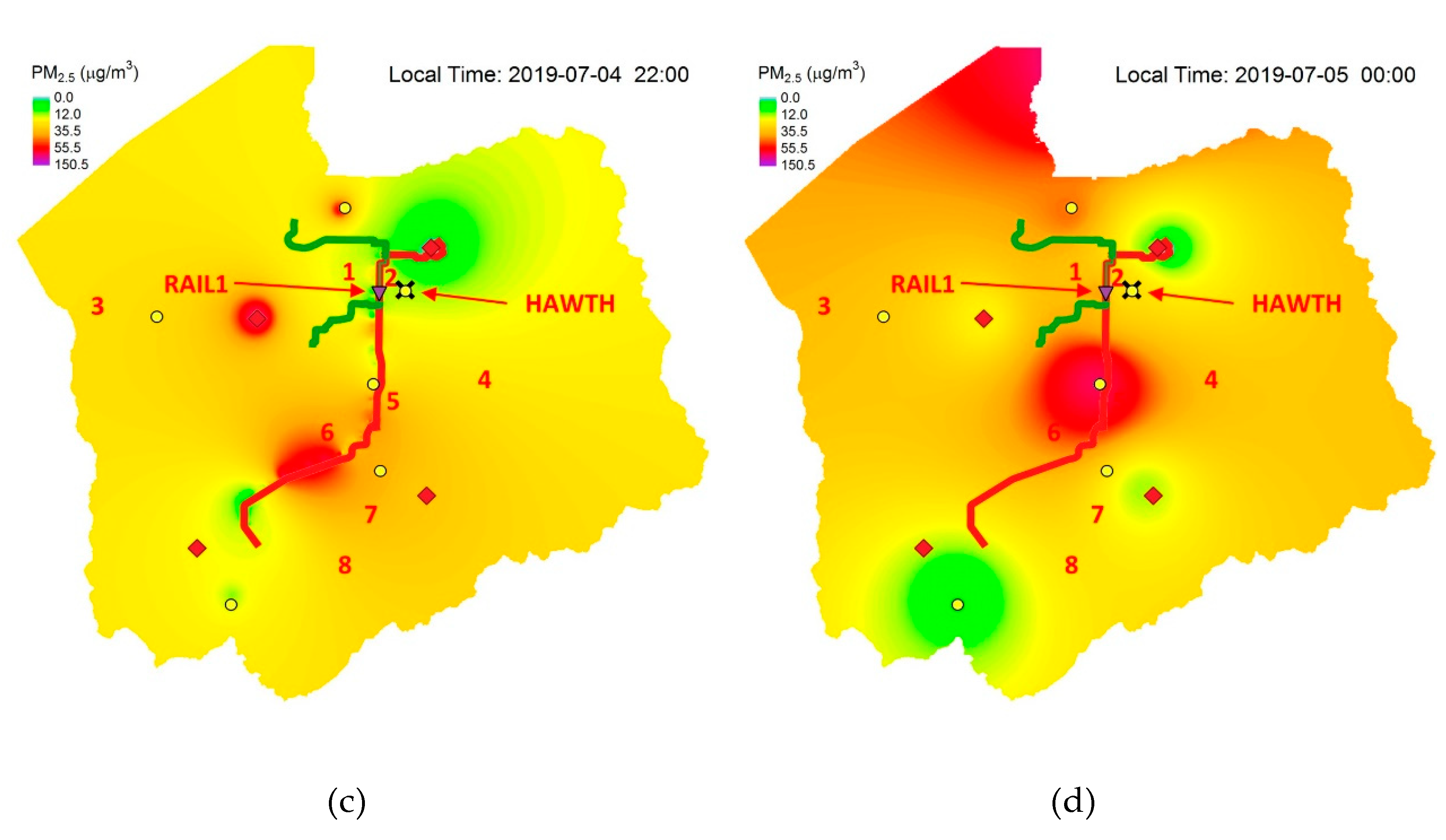

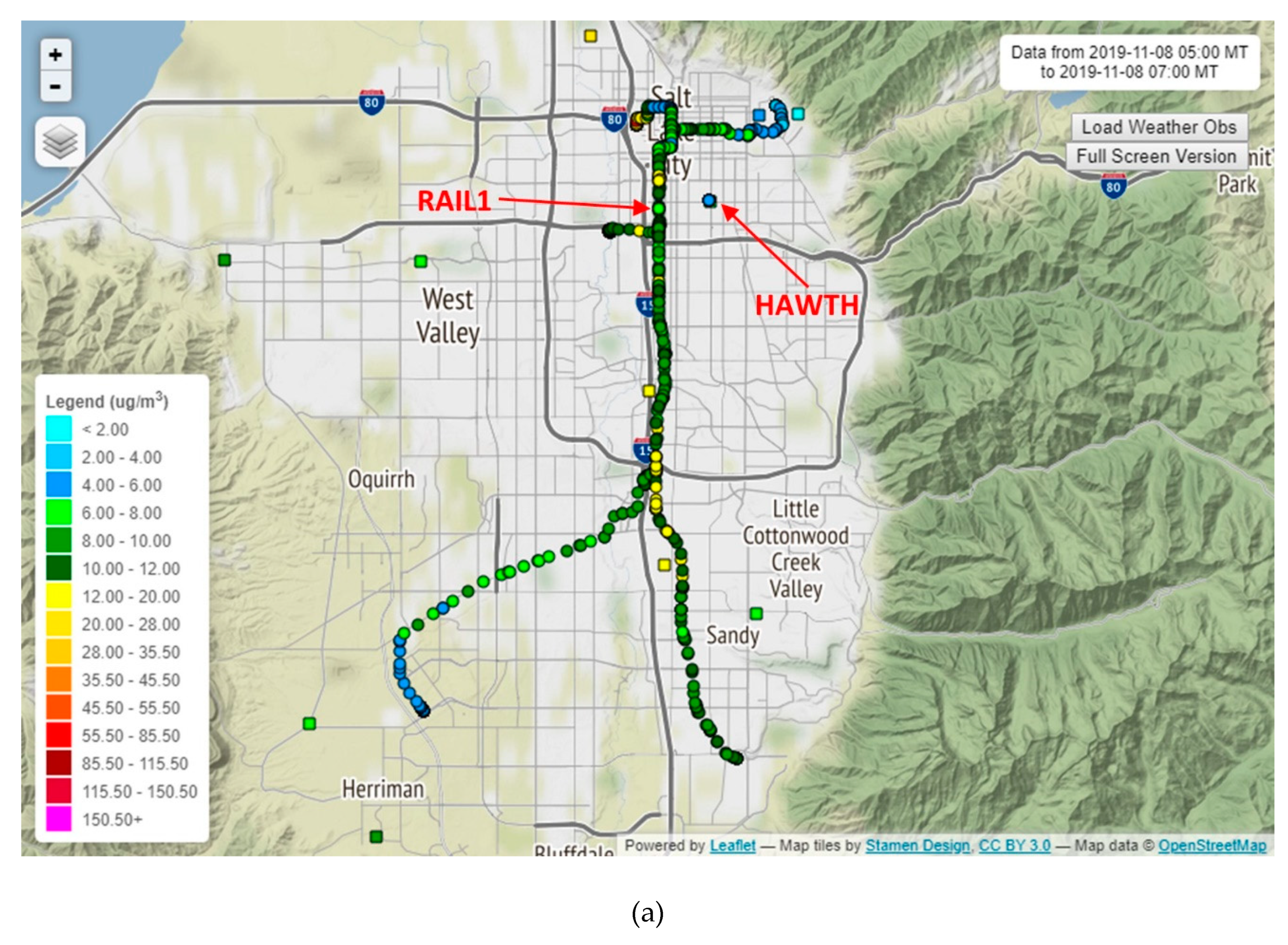
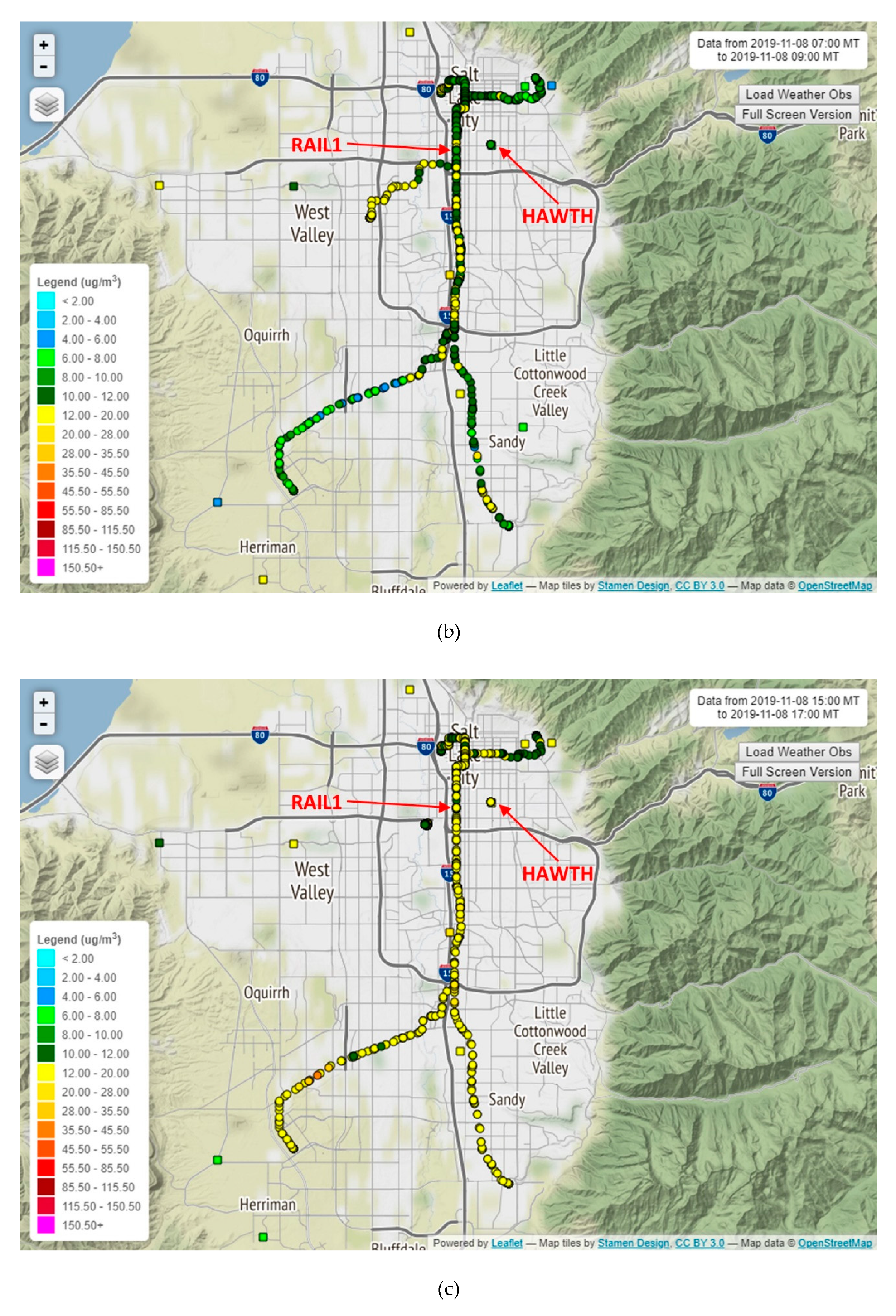
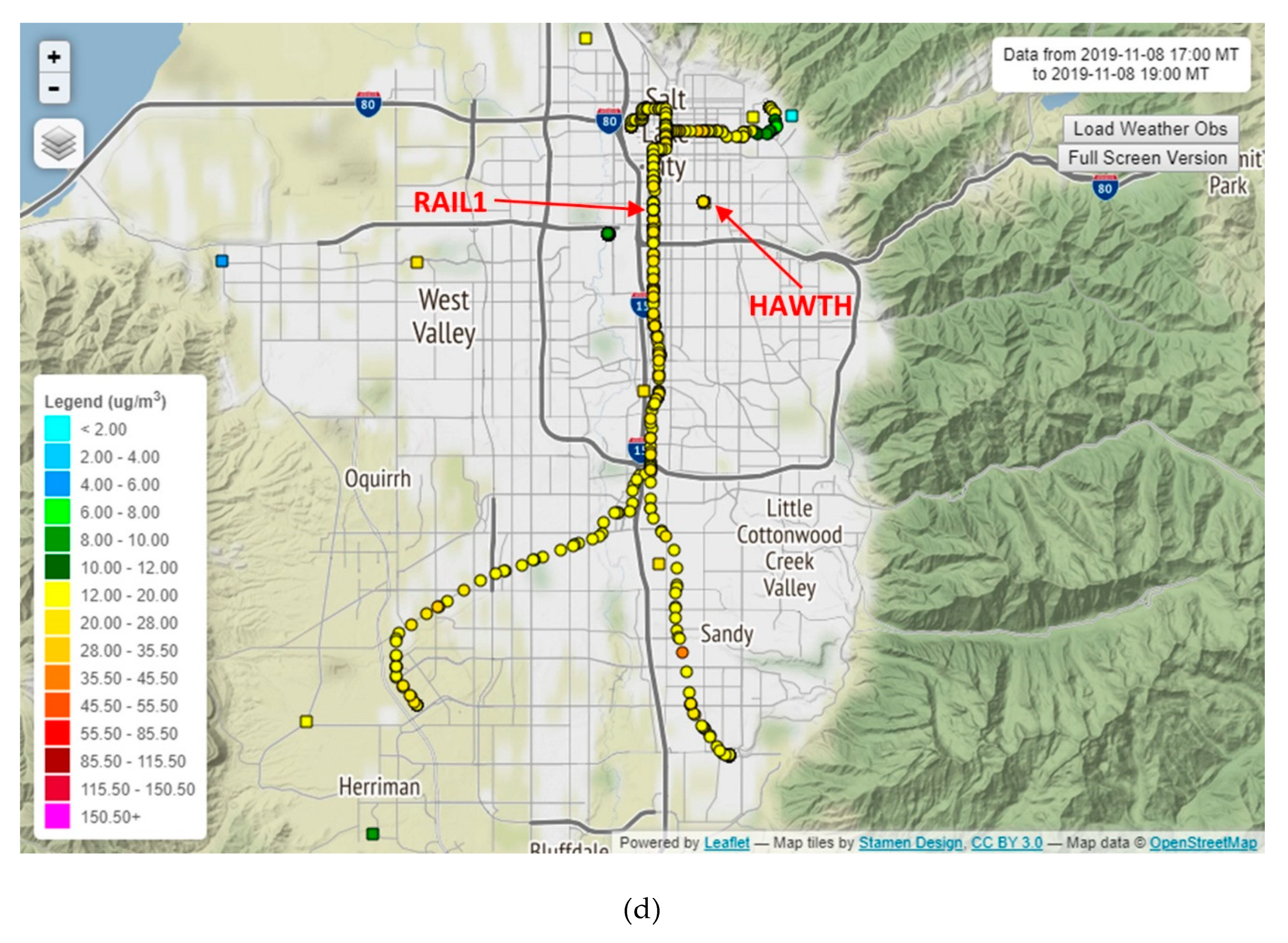
| Location | Purpose | Instruments | Date Installed |
|---|---|---|---|
| TRAX TRAIN 1 (TRX01—car 1136) | Mobile sampling of data and TRAX along the Red and Green lines. | 1. Met One Instruments ES-642 Remote Dust Monitor and 1 2B Technologies Model 205 Ozone Monitor, cell modem, GPS, CR1000 datalogger, power supply, and 120 A power inverter | 26 November 2018 |
| TRAX TRAIN 2 (TRX02—car 1104) | Mobile sampling of data and TRAX goes along the Red and Green lines. | Same as TRX01 | 26 November 2018 |
| TRAX TRAIN 3 (TRX03—car 1034) | Mobile sampling of data and TRAX goes along the Blue line. | Same as TRX01 | 4 November 2019 |
| Fixed site 1 (RAIL1): UTA power station along primary track. 1777 S, 300 W Salt Lake City | Quantifying train motion on inlet effects. Purpose of site is to quantify any biases in TRAX measurements due to the speed of the train impacting particle collection/sampling efficiency | 1. Met One Instruments ES-642 Remote Dust Monitor cell modem, CR1000 datalogger, power supply | 10 December 2018 |
| Fixed site 2 (HAWTH): UDEQ Hawthorne Elementary School 1675 S, 600 E Salt Lake City | Calibration and validation. Purpose of site is to provide a baseline for quantifying any differences between TRAX sensors and higher quality UDEQ measurements. | 1. Met One Instruments ES-642 Remote Dust Monitor cell modem, CR1000 datalogger, power supply | 17 December 2018 |
| Site | Name | City | Start Time |
|---|---|---|---|
| 1 | Jordan Park | Salt Lake City | 22:00 MDT |
| 2 | Smith’s Ballpark | Salt Lake City | 22:45 MDT |
| 3 | Copper Park | Magna | 22:00 MDT |
| 4 | City Hall Park | Holladay | 22:00 MDT |
| 5 | Murray Park | Murray | 22:00 MDT |
| 6 | Veteran’s Memorial Park | West Jordan | 22:15 MDT |
| 7 | South Towne Promenade | Sandy | 22:00 MDT |
| 8 | Riverton City Park | Riverton | 22:00 MDT |
© 2019 by the authors. Licensee MDPI, Basel, Switzerland. This article is an open access article distributed under the terms and conditions of the Creative Commons Attribution (CC BY) license (http://creativecommons.org/licenses/by/4.0/).
Share and Cite
Mendoza, D.L.; Crosman, E.T.; Mitchell, L.E.; Jacques, A.A.; Fasoli, B.; Park, A.M.; Lin, J.C.; Horel, J.D. The TRAX Light-Rail Train Air Quality Observation Project. Urban Sci. 2019, 3, 108. https://doi.org/10.3390/urbansci3040108
Mendoza DL, Crosman ET, Mitchell LE, Jacques AA, Fasoli B, Park AM, Lin JC, Horel JD. The TRAX Light-Rail Train Air Quality Observation Project. Urban Science. 2019; 3(4):108. https://doi.org/10.3390/urbansci3040108
Chicago/Turabian StyleMendoza, Daniel L., Erik T. Crosman, Logan E. Mitchell, Alexander A. Jacques, Benjamin Fasoli, Andrew M. Park, John C. Lin, and John D. Horel. 2019. "The TRAX Light-Rail Train Air Quality Observation Project" Urban Science 3, no. 4: 108. https://doi.org/10.3390/urbansci3040108
APA StyleMendoza, D. L., Crosman, E. T., Mitchell, L. E., Jacques, A. A., Fasoli, B., Park, A. M., Lin, J. C., & Horel, J. D. (2019). The TRAX Light-Rail Train Air Quality Observation Project. Urban Science, 3(4), 108. https://doi.org/10.3390/urbansci3040108






